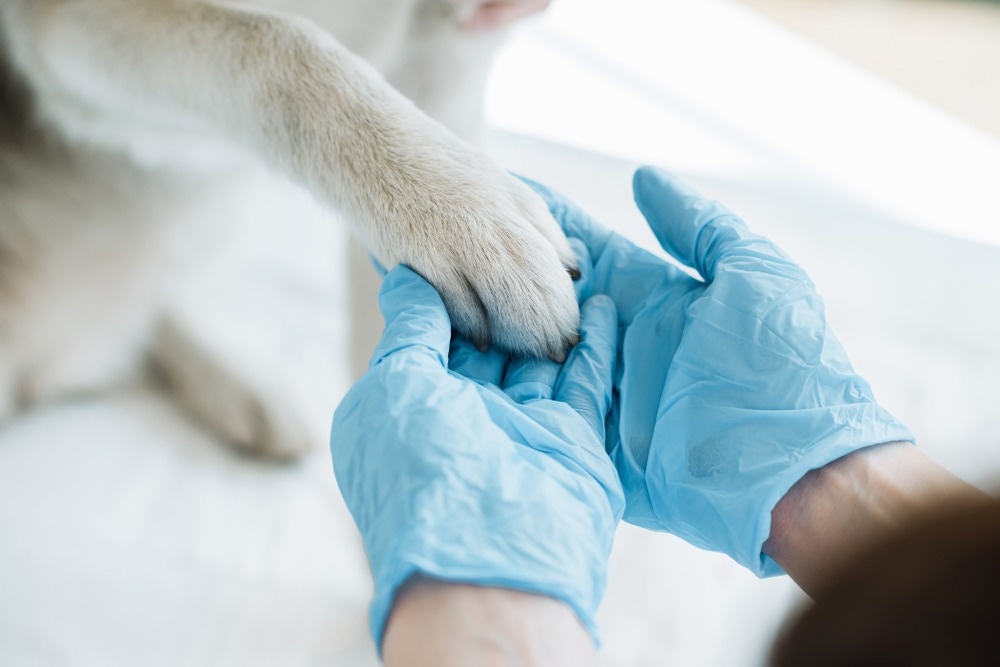 Interview conducted by Danielle Ellis, B.Sc.Oct 26 2022
Interview conducted by Danielle Ellis, B.Sc.Oct 26 2022In this interview, News-Medical speaks to Professor Roberto La Ragione, Chair of Trustees at Humanimal Trust, about the concept of One Medicine and how human and veterinary medicine can collaborate, share knowledge, and initiate research for the benefit of both humans and animals.
Please can you introduce yourself, tell us about your professional background, and your role at Humanimal Trust?
I am Professor Roberto La Ragione, Chair of Trustees at Humanimal Trust.
I graduated in 1995 and then studied for a postgraduate degree in veterinary microbiology at the Royal Veterinary College (University of London). In 1996, I moved to the government's Veterinary Laboratories Agency (VLA) to undertake a Ph.D. on the pathogenesis of E. coli in poultry. Upon completing my Ph.D. studies, I commenced a post-doctoral position at Royal Holloway, University of London, studying E. coli virulence factors and vaccine development.
Since 2001, my work has focused largely on understanding the pathogenesis of zoonotic bacterial pathogens to develop control strategies. I have led several commercial, Defra, research councils (BBSRC, MRC, EPSRC, AHRC, Innovate) and EU projects in this area.
My current research interests focus on the pathogenesis of food-borne pathogens with a particular interest in Antimicrobial Resistance (AMR) and the development of intervention strategies, including vaccines, rapid diagnostic, pre, and probiotics. I have published over 190 papers in the area of host-microbe interaction, with a particular emphasis on E. coli, Salmonella, vaccines, probiotics, and AMR.
In 2005, I was appointed Head of Pathogenesis and Control at the AHVLA, and in 2010, I was appointed Professor of Veterinary Microbiology and Pathology at the University of Surrey. I gained the FRCPath in 2010, and in 2012, I was appointed the Associate Dean for Veterinary Strategy in the new School of Veterinary Medicine at the University of Surrey. In 2014, I was appointed to the position of Head of the Department of Pathology and Infectious Diseases and Director of the Veterinary Pathology Centre. In 2019 I was appointed Deputy Head of the School of Veterinary Medicine at the University of Surrey, and then in 2021, I was appointed Head of the School of Biosciences and Medicine.
I am the past president of the Med-Vet-Net Association and the Veterinary Research Club, the current Chair of Humanimal Trust, a member of the FSA ACMSF AMR sub-committee, a Trustee of the Houghton Trust, a member of the APHA Science Advisory Board and Chair of the Royal College of Pathologists Veterinary Pathology SAC. I am an Associate member of the European College of Veterinary Microbiology, and in 2020, I was awarded an Honorary Associateship of the Royal College of Veterinary Surgeons.
Humanimal Trust is a unique organization. Please could you tell us about the organization’s origin, purpose, and values?
Humanimal Trust is the only organization in the UK with the sole and specific purpose of progressing One Medicine.
It was founded in May 2014 by world-renowned orthopedic-neuro veterinary surgeon Professor Noel Fitzpatrick - otherwise known as the TV Supervet. As a vet, Noel Fitzpatrick experienced personally the deep divide between human and animal medicine and saw how unfair this was.

Image Credit: LightField Studios/Shutterstock.com
Frustrated by the lack of opportunities to share what he was learning from veterinary practice or to benefit from relevant learning from human medicine, he decided to create the platform himself. This laid the foundations for the work Humanimal Trust does today, removing barriers and seeking to close the divide between human and animal medicine.
Our five areas of work spell out I-CARE, which sums up the way we feel, our supporters feel, and we hope everybody will one day feel about One Medicine:
- Influence – we care about bringing together everyone who cares about One Medicine to create a road map for change in public policy, education, and at the clinical coalface.
- Collaboration – we care about creating opportunities for human and veterinary professionals and students to learn from one another (in person and virtually) by demonstrating One Medicine at work.
- Awareness - we care that people should know and understand the benefits of One Medicine for humans and animals, about non-animal alternatives to laboratory models, and how much human and animal medicine can learn from one another’s clinical practice – saving time, money, and lives.
- Research – we care about research – funding it, facilitating it, shouting about it – that could benefit humans and animals without using laboratory animal models.
- Education – we care about learning – every child learning about the connections between humans and animals; veterinary and human medical students learning with and from one another; practitioners learning continuously from their peers.
Humanimal Trust advocates for One Medicine. What is One Medicine, when did this concept originate, and how has the understanding of it evolved in recent years?
The origins of One Medicine date back to the nineteenth century when Rudolf Virchow linked human and animal health. Sir William Osler, Dr. Calvin Schwabe, Lord Lawson Soulsby, and others have since continued to expand the One Medicine concept, identifying the connections, commonalities, and synergies between human and veterinary medicine.
It was whilst studying the history of medicine that Professor Fitzpatrick came upon a term used to describe human and veterinary medicine working with one another: One Medicine. The third edition of Dr. Calvin Schwabe’s seminal publication in 1984 of ‘Veterinary Medicine and Human Health’ which spoke of One Medicine, laid the foundation for what we now know as One Health, but in considering this text, Fitzpatrick identified a need to move away from a public health agenda to a common health agenda focusing on infectious and non-infectious diseases.
Moreover, when reviewing the three Rs (refinement, reduction, and replacement) in relation to animal use in research, it became clear that a fourth R was missing from the 3Rs principle – the principle of reciprocity so that not only do medical practitioners and allied researchers benefit, but also patients, regardless of their species.
By considering the contribution that animals can make to research by studying their lives and their responses to naturally occurring, spontaneous diseases rather than using experimental animal models in research, the use of animals in research can be significantly reduced.
One Medicine and the 'Biology of the Future' (Biology Week 2020)
Why is it currently the case that human and veterinary medicine are kept separate, and why would it be beneficial to change this?
Although the practice of bringing veterinary and human medical and research professionals together is thought to stimulate new and innovative research, historically, this has been challenging. A number of studies have investigated why this could be, and different levels of awareness and priorities may be one reason. A 2020 study, which surveyed vets and GPs in Australia, found that vets generally had more awareness and felt more confident in engaging in zoonoses management compared to GPs, and were also more likely to initiate cross-professional referrals.
The Trust believes that education is key to One Medicine. Only by learning about the similarities between humans and animals from the earliest stage to collaboration in the most advanced science and clinical practice will we promote change. Therefore, we must ensure that the best research, clinical practice and learning, benefiting both humans and animals, are accessible, funded, encouraged, and promoted.
A study published in 2017 by a group of scientists in The Netherlands noted that having a clear common goal (like One Medicine) can help to stimulate collaboration. The study also suggested that professional organizations could be important facilitators of collaboration in this area.
With this in mind, in 2020, the Trust launched the Humanimal Hub, a free online platform for all human and animal medical and veterinary professionals to meet, collaborate, share knowledge, and initiate research for the benefit of both humans and animals.
While still in its infancy, the Hub already has over 250 members. It provides a much-needed virtual space for connections to be made and conversations to be initiated, which the Trust actively seeks to nurture. For example, Anna Radford, a Consultant in Paediatric Surgery at Hull University NHS Trust and Leeds Children’s Hospital, was looking to collaborate with an individual or group in veterinary medicine with a specialty in problems with urinary tract or kidneys and/or antimicrobial resistance. Through the Hub, we were able to identify a suitable professional, and as a result, an interdisciplinary group has been set up to identify common urological conditions affecting both humans and companion animals.
Anna was also introduced to a diagnostics company working in the animal medical care field at the Trust’s inaugural global ‘One Medicine Symposium: Stronger Together’ in May 2021. Through them, Anna has set up a new collaboration to determine whether this diagnostic technology developed with companion animal medicine in mind could potentially also be useful to help diagnose urinary, joint, and cerebrospinal fluid infections in a busy NHS hospital setting.
These are just two examples of how we know that great things can happen when animal and human health professionals and scientists come together.
Which areas of medicine do you currently focus on, and what benefits does One Medicine provide to this particular area?
I believe One Medicine has transformative potential across all areas of medicine where physiological and genetic similarities exist between humans and animals. There are five main pillars of research that the Trust currently seeks to fund, namely infection control and antimicrobial resistance; cancer; bone and joint disease; brain and spinal disease; and regenerative medicine.
In line with this, the Trust began an important collaboration with the children’s charity Action Medical Research in 2020 to help support two child-focused medical research projects. The first study, led by Professor Hall-Scraggs at University College London, focuses on juvenile idiopathic arthritis (JIA). Patients with JIA have a disease that causes inflammation of their joints. This leads to pain, joint deformity, disability, and reduced quality of life. There are newer drugs now available that suppress joint inflammation, but these are expensive and can have side effects, the most serious being life-threatening infection. Magnetic resonance imaging (MRI) scans can show inflammation of joints. By measuring inflammation in patients with juvenile idiopathic arthritis, the study could help optimize their treatment by showing how much inflammation is present and whether it changes with treatment.

Image Credit: Amir Bajric/Shutterstock.com
The second study, which is ongoing, is investigating infection prevention and its impact on antimicrobial resistance in critically ill children, led by Dr. Nazima Pathan, Lecturer in Paediatric Intensive Care at the University of Cambridge. The transferable data from both studies has real potential to help improve the lives of humans and animals with similar conditions.
Another example of research the Trust has funded concerns liquid biopsies for canine patients. This research was undertaken by Professor Joanna Morris and Dr. Tomoko Iwata at the University of Glasgow and is a great example of reciprocity whereby human and animal bladder cancer patients may benefit from this research.
Are there any particular examples of where either human or veterinary medicine has led to advances in the other?
Cancer research is perhaps the area for which One Medicine is most well-known. For example, dogs, long considered our best friends, don’t just share our lives but also risk factors for certain diseases. Many diseases also share genetic similarities between humans and dogs. Canine lymphoma, the second most common cancer in dogs, has relatively similar characteristics to human non-Hodgkin lymphoma. Around 1 in 8 golden retrievers will develop canine lymphoma, and CRUK estimates that 1 in 39 males and 1 in 51 females are at risk of being diagnosed with non-Hodgkin lymphoma. Both species need better, more effective ways to treat the disease, and clinical trials with canine veterinary patients have been helping to fast-track the development of new treatments in this area for several years.

Image Credit: Varvara Serebrova/Shutterstock.com
The US-based DISCO initiative recognizes the value of aligning veterinary and human drug development projects and explains why it can be worthwhile to include veterinary patients at an early stage in cancer drug development trials. From shortening drug development times to encouraging cross-collaboration between the disciplines for the benefit of both human and veterinary patients, the potential advantages of this approach are clearly laid out in a landmark 2019 paper, which came about from a workshop of the World Small Animal Veterinary Association’s One Health committee.
What is the one thing you wish people knew about One Medicine?
One Medicine is about human and animal healthcare advancing hand in hand, in an equitable and sustainable way, and not at the expense of an animal’s life.
How can people, both medical professionals and the general public, get involved with Humanimal Trust and support the One Medicine cause?
Human and animal medical professionals, students, and researchers can join the Humanimal Hub for free and use it as an opportunity to collaborate, share knowledge, and initiate research with other like-minded individuals. The Trust also holds an annual One Medicine Day event that brings together researchers, doctors, vets, allied healthcare professionals, and students from around the world to discuss practical ways forward for One Medicine. The year’s ‘One Medicine Day Seminar: One Medicine in Action’ talks can be found here.
There are also opportunities to join our team as a volunteer Ambassador, write articles for us, present at events or act as a moderator for the Hub.
There are many ways that members of the public interested in One Medicine can get involved too, from signing The Humanimal Pledge or organizing a Paws for a Picnic fundraiser with family and friends to leaving a gift in your will or becoming a volunteer speaker in your local community.
What is next for yourself and Humanimal Trust?
We recognize the need to present One Medicine consistently through an education lens. Our absolute priority is to improve understanding at every level - from pre-school to professional training (veterinary and medical undergraduates) and development - of the relationship between human and animal health and the need for collaboration and reciprocity of benefit to humans and animals.
With this in mind, our focus for the next twelve months is on four key areas of activity:
- Focused awareness building among key audiences
- Developing partnerships, networks, and collaborations
- Education
- Research funding, engagement, and influencing activity
To help drive this, we have appointed a new CEO, Joe Bailey, who will be joining us in November from RSPCA Assured, together with a new Trustee, Anna Radford, whom I referred to earlier. I have no doubt that their understanding of and passion for our purpose will help take Humanimal Trust to the next level.
We are expanding our Science Committee, which will strengthen our ability to draw on the best available expertise to make better-informed decisions about which research activities we prioritize for funding or support. In addition, to support the strategic development of our educational program, we have created a new role - Schools Education Manager - which will enable us to initiate the long-term development of a One Medicine curriculum.
We will soon launch our new Podcast series, which I’m very excited about. This will follow the Trust’s previous series, Humanimal Connection, but with a very different feel to it, so watch this space.
Where can readers find more information?
Further details can be found on our website: https://www.humanimaltrust.org.uk/
You can also email us at [email protected] and follow us on Facebook, Instagram, Twitter, and LinkedIn.
About Professor Roberto La Ragione, BSc (Hons) MSc Ph.D. FRSB CBiol FIBMS CSci AECVM FRCPath HonAssocRCVS
I am a Professor of Veterinary Microbiology and Pathology in the School of Veterinary Medicine and the Head of the School of Biosciences and Medicine at the University of Surrey.  My role includes delivering and overseeing teaching and research in the School and running my own research group, which consists of vets, doctors, and scientists. My current research interests focus on Antimicrobial Resistance (AMR) and understanding the pathogenesis of zoonotic bacterial pathogens (those that can be transmitted from animals to humans and, in some cases, from humans to animals). I also have a particular interest in developing control and intervention strategies, including rapid diagnostics, vaccines and probiotics for controlling bacterial pathogens in companion and food-producing animals. I have published over 190 peer-reviewed papers in the area of microbiology and pathology.
My role includes delivering and overseeing teaching and research in the School and running my own research group, which consists of vets, doctors, and scientists. My current research interests focus on Antimicrobial Resistance (AMR) and understanding the pathogenesis of zoonotic bacterial pathogens (those that can be transmitted from animals to humans and, in some cases, from humans to animals). I also have a particular interest in developing control and intervention strategies, including rapid diagnostics, vaccines and probiotics for controlling bacterial pathogens in companion and food-producing animals. I have published over 190 peer-reviewed papers in the area of microbiology and pathology.